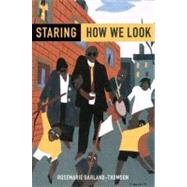
Staring How We Look
by Garland-Thomson, RosemarieBuy New
Buy Used
Rent Textbook
Rent Digital
How Marketplace Works:
- This item is offered by an independent seller and not shipped from our warehouse
- Item details like edition and cover design may differ from our description; see seller's comments before ordering.
- Sellers much confirm and ship within two business days; otherwise, the order will be cancelled and refunded.
- Marketplace purchases cannot be returned to eCampus.com. Contact the seller directly for inquiries; if no response within two days, contact customer service.
- Additional shipping costs apply to Marketplace purchases. Review shipping costs at checkout.
Summary
Author Biography
Rosemarie Garland-Thomson is Professor in the Department of Women's Studies at Emory University. She was named one of 2009's "50 Visionaries Who Are Changing Your World" by UTNE Reader.
Table of Contents
| About Staring | |
| Why Do We Stare? | |
| What Is Staring? | |
| Staring: A Physical Response | |
| Staring: A Cultural History | |
| Staring: A Social Relationship | |
| Staring: Knowledge Gathering | |
| Don't Stare | |
| Staring: Getting into Trouble | |
| Staring: Bad Manners | |
| Staring: Rules and Rebellion | |
| Starers and Starees | |
| Looking Away, Staring Back | |
| Scenes of Staring | |
| Staring at Faces | |
| Staring at Hands | |
| Staring at Bodies | |
| Staring at Breasts | |
| Beholding | |
| Table of Contents provided by Publisher. All Rights Reserved. |
An electronic version of this book is available through VitalSource.
This book is viewable on PC, Mac, iPhone, iPad, iPod Touch, and most smartphones.
By purchasing, you will be able to view this book online, as well as download it, for the chosen number of days.
Digital License
You are licensing a digital product for a set duration. Durations are set forth in the product description, with "Lifetime" typically meaning five (5) years of online access and permanent download to a supported device. All licenses are non-transferable.
More details can be found here.
A downloadable version of this book is available through the eCampus Reader or compatible Adobe readers.
Applications are available on iOS, Android, PC, Mac, and Windows Mobile platforms.
Please view the compatibility matrix prior to purchase.
